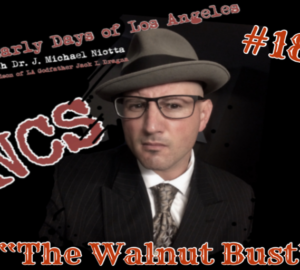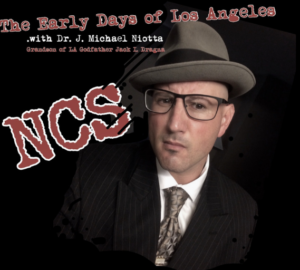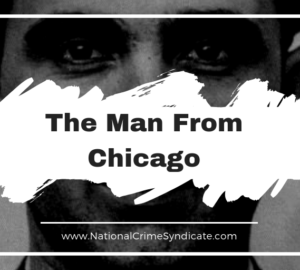Author’s Note – These installments on early LA seek to highlight the lesser known events and relationships pertaining to crime activity in the Southland. They are also intended to clear the conjecture that continues to cloud the true events that transpired. As John Buntin so aptly penned in LA Noir, “Other cities have histories. Los Angeles has legends.” To add to this, in regard to the City of Angels, the early days were exciting enough without embellishing. Installment 2 deviates from the formula just slightly by looking at more recent times, but it’s done in an effort to point out an inaccuracy long hanging over the reputation of “the old days.”
The Los Angeles Crime Family has been branded with the derogatory label, the “Mickey Mouse Mafia,” and not due to its proximity to the famed theme park either. The claim that Cosa Nostra families back East thought of the LA Family as small time, or even as a joke, has been made by crime historians, mafia genre magazines such as Mob Candy, and a slew of true crime books. The contention has been further perpetuated by hordes of social media posts from bloggers, mafia enthusiasts, and mob forum fans. Even gangster trading cards have subscribed. But where did the phrase actually come from? Who said it first? And when?
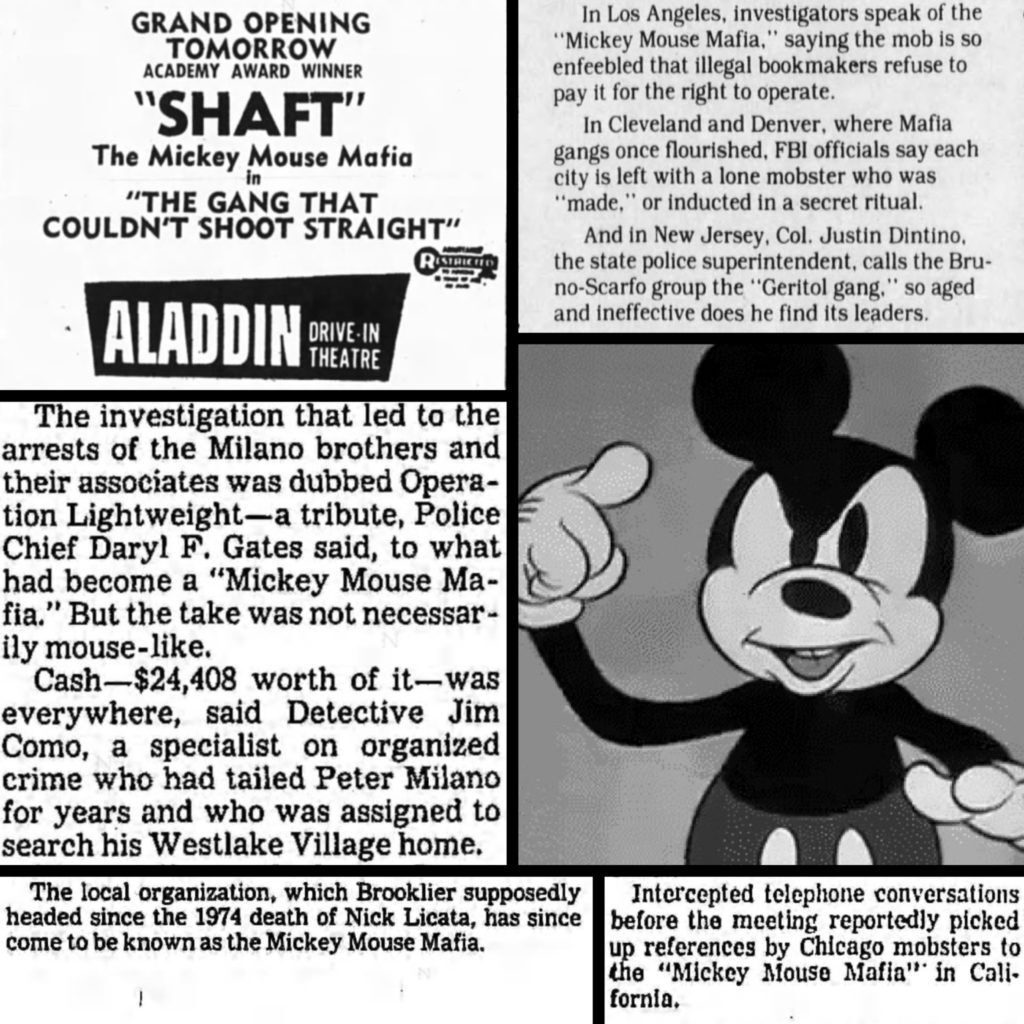
If you’ve read the work of Judith Moore—perhaps best known for her somewhat sensationalized mid-to-late-90s San Diego Reader articles about hitman Frank Bompensiero—then you might believe the term was generated decades back and was geared toward the crime organization under the reign of longtime leader, Jack Dragna. But the timeline doesn’t add up. When The Los Angeles Times first tagged LA’s Italian crime fraternity with the belittling moniker, newsmen were merely quoting the words of then police chief, Daryl Gates. Although Gates joined the force under Chief William H. Parker prior to the Kefauver Hearings—right around the time attempts on the life of Mickey Cohen brought bomb blasts and shotgun sounds to the streets of Los Angeles—he didn’t actually head up the department until 1978. And despite having firsthand knowledge of LA’s Post War criminal background, the comment he made was actually directed at present activities. He was talking about the leadership of the LA Crime Family during the early part of the eighties, which proved to be a truly turbulent time for Angeleno Cosa Nostra members, who suffered considerable and frequent difficulties in controlling bookmaking and pornography rackets and with staying out of jail.
“The investigations that led to the arrests of the Milano brothers and their associates was dubbed Operation Lightweight—a tribute Police Chief Daryl F. Gates said, to what had become a ‘Mickey Mouse Mafia.’”
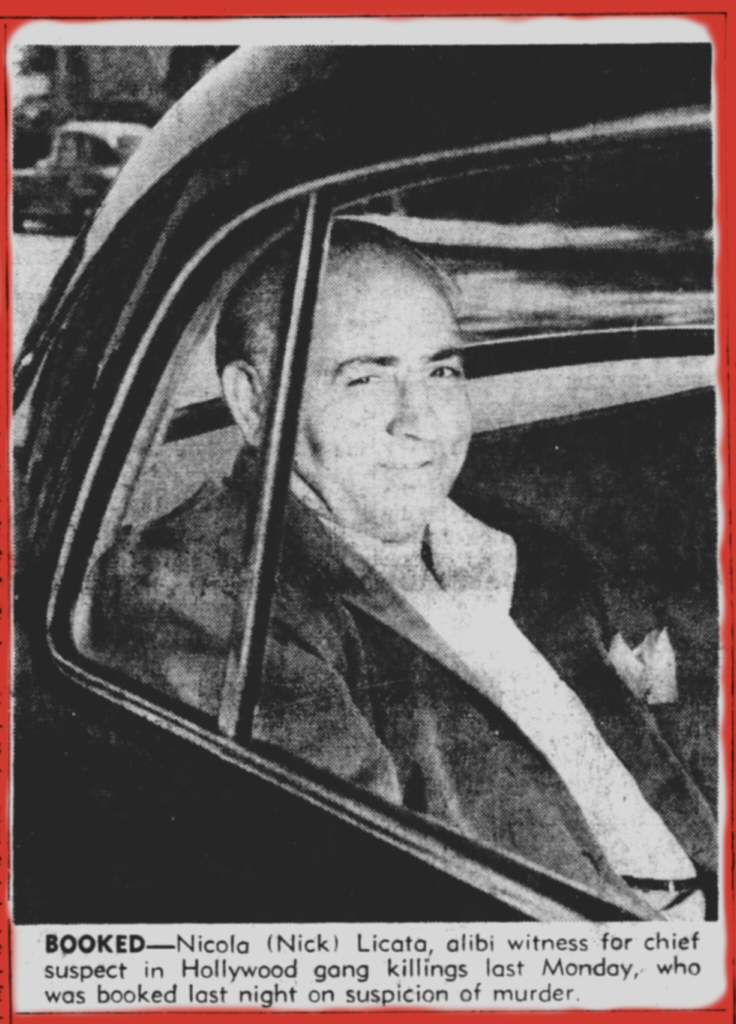
Lightweight began shortly before the death of LA Mob Boss Dominic Brooklier. This successor to Nick Licata died before finishing a five year stint of “reeducation” out in Tucson. Brooklier passed in the summer of 1984, a week before the Olympic Games in Los Angeles kicked off. Brooklier’s absence during incarceration and then in death had authorities speculating over who had taken over as head of the criminal enterprise. Eventually they would come to learn Peter Milano was elected. At the reigns, Milano made a play for the Southland’s million-dollar-a-week bookmaking operations, but he was quickly thwarted by Chief Gates’ ongoing investigation. A raid on 22 bookie houses spread throughout the Inland Empire and Ventura, Los Angeles, and San Diego Counties resulted in the arrest of 20. A heavy hit for Cali’s Cosa Nostra. After nabbing brothers Peter and Carlo Milano, who by then authorities considered family leaders, Chief Gates indicated he felt the operation’s name was fittingly “appropriate.” “Organized crime,” he added, was “such a lightweight in Southern California.” But again, Gates was not speaking to the earlier days of Los Angeles, as further reports have indicated.
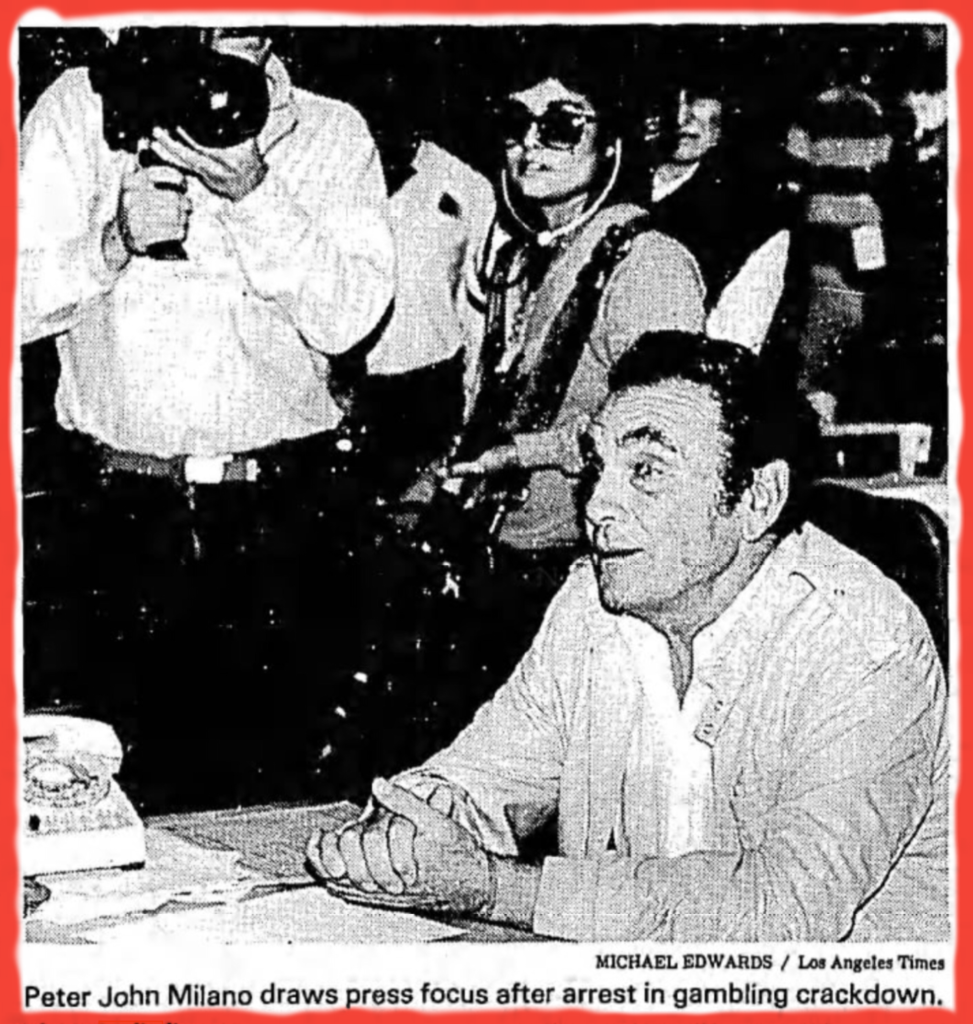
“The local organization, which Brooklier supposedly headed since the 1974 death of Nick Licata, has since come to be known as the Mickey Mouse Mafia.”
Though Chief Daryl Gates is sometimes credited as the originator of the saying, a simple database search shows that the phrase was in use during the previous decade. In 1971, it could be seen as a tag line in advertisements for the mafia mockery comedy, The Gang That Couldn’t Shoot Straight—a picture which, ironically, poked fun at New York’s crime families rather than LA’s. A couple years after that, the title surfaced again as the name of an all girls junior baseball team out in Weber County. And come 1980, roughly four years before Chief Gates mouthed the words to SoCal reporters, another source used it; this time the phrase WAS used to describe the LA Mob. In fact, this is more than likely the source Chief Gates made reference to. Newsmen in 1980 took the line from a recently leaked wire-tapped conversation.
“Intercepted telephone conversations before the meeting reportedly picked up references by Chicago mobsters to the ‘Mickey Mouse Mafia’ in California.”
Based on the timeline, this leaked portion of the conversation was likely a response to the recent activities of LA Family hitman, Aladena “Jimmy the Weasel” Fratianno. Further angering the national syndicate, the Weasel had done far more than merely break the code of omertà. At the time this phone call from Chicago was tapped, Fratianno was busy touring the country testifying against his fellow mafiosi. Likely also on the minds of these unhappy Chicago operators was the fairly recent hit on another of California’s hitmen believed to be an informant. Bullets riddled the body of Frank “Bomp” Bompensiero in a San Diego telephone booth in 1977.
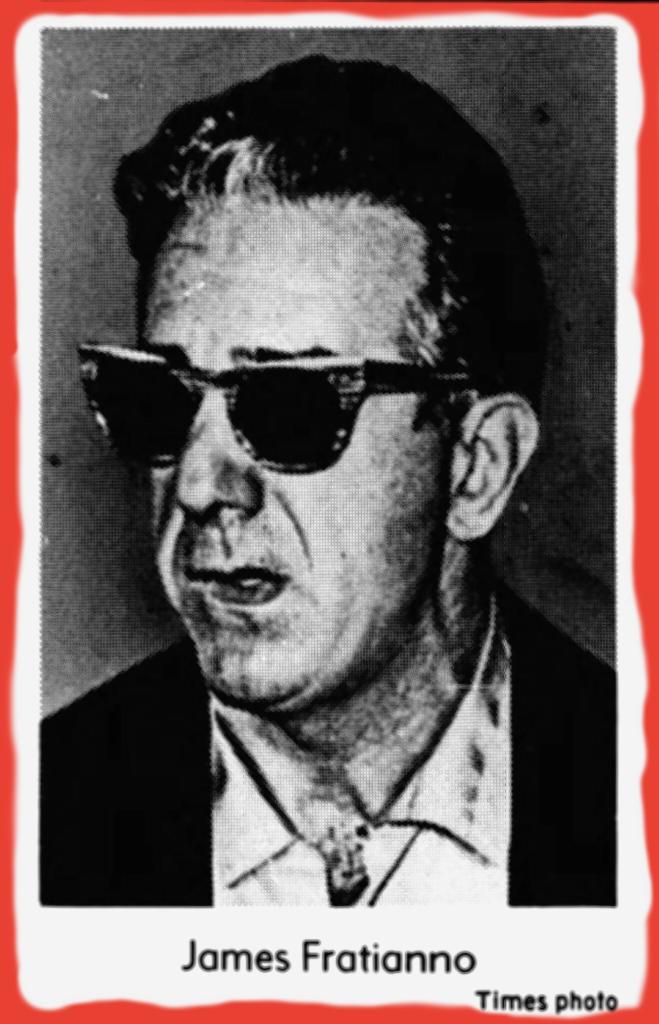
Despite what has become popular belief (though perhaps more in line with mythology), there are no earlier known sources which substantiate the claim that Cosa Nostra families back East felt this way about their West Coast counterparts or ever called them “Mickey Mouse.” To the contrary, close personal friendships that involved wives and children and included month-long visits, paired with joint business endeavors in bootlegging, a shakedown of the Hollywood unions, and syndicated gambling efforts such as establishing Trans American wire service, all suggest that at very least, an amicable relationship existed. Friendships and arrangements that began in the early twenties with the brokering of sales and distribution of wine grapes and booze during prohibition, managed to survive the great depression and a purge of the old Sicilian “Boss of Bosses” system. These ties even carried on past the country’s war years and can still be seen in close family friendships among grandchildren who reside on opposite ends of the country.
In addressing mob enthusiasts who subscribe to the popular practice of comparing early crime players in Los Angeles to comical Disney characters in an effort to belittle them, I have found myself time and time again referencing the work of another West Coast crime historian. “It seems ironic that the mention of Jack Dragna’s reign as the godfather of early LA crime often earns chuckles,” was expressed by Warren R. Hull, a man deemed a Los Angeles crime expert by the Las Vegas Mob Museum. In Hull’s book, Family Secret, which predominately centers on the killing of Jewish gangster, Benjamin “Bugsy” Siegel, the author, crime historian slash movie producer humorously points out,
“Does anybody realize how much money that fuckin’ mouse makes in a year?”
Although Disneyland’s doors didn’t actually open until a few years before Jack Dragna’s 1956 death, comparisons of famed Disney characters and LA racketeers did commence a few years earlier. During the late 1940s, journalists took turns jabbing at Jewish lightweight boxer turned bookmaker hoodlum, Mickey Cohen. Newsmen dubbed him “Mickey Mouse Cohen” and even more shameful—“Snow White.” Following suit, Cohen’s henchman were popularly referred to in print as the “Seven Dwarfs.” Nowhere in the newspaper pages of the 1940s, 50s, or even 60s is the phrase “Mickey Mouse Mafia” printed.

Although the Mickey Mouse title doesn’t come into play in his acclaimed book, Five Families, Selwyn Raab did point out that at least one individual had a gripe about the leadership out West after Jack Dragna’s passing. Due to internal conflicts in New York, Bonanno Crime Family Boss, Joseph “Joe Bananas” Bonanno turned over control of his operations in the East and left for the West, settling into a home in Arizona that he’d purchased back in the 40’s. According to Raab, Bonanno felt that Dragna’s immediate successor, Frank DeSimone, was a less than capable replacement. Perhaps because he could not safely return to the rackets of New York, during the 1960s Joe Bonanno made a failed play at taking over the California rackets. And a decade later, with the waning health of Nick Licata, who stepped in as Boss of Los Angeles after the death of Frank DeSimone, Bonanno again plotted to take California.
When Nick Licata fell ill in 1974, he never recovered. Also detrimental to the leadership structure of the LA Family, a heart attack took their second in charge, Under Boss Joe “Dip” Dippolito, nine months before Licata’s passing. Wanting to carve out a brighter crime future for his then incarcerated son “Bill,” who was slated for a soon coming prison release, Joe Bonanno enticed San Diego based LA Family member, Frank Bompensiero, to get on board with a mutiny. The plan ultimately sought to install the younger Bonanno in the California throne and promised Bompensiero a nice raise for his part in the caper. To the senior Bonanno’s dismay; however, the plot did not receive sanction by the New York Commission.
California’s organized criminals, not unlike those operating in other territories across the country, definitely faced their share of challenges while attempting to maintain control of turf and rackets. And following suit, Angelenos were not the only ones that newsmen poked fun at. During the same timeframe that the phrase “Mickey Mouse Mafia” sprouted, journalists also highlighted the dwindling strength of the Detroit Partnership and even went as far as to refer to Philly’s Bruno-Scarfo family as the “ineffective” and aging “Geritol Gang.”
Perhaps somewhat in the defense of California, one thing that certainly set them apart during the Post World War II era was a new force that outlaw entrepreneurs and underworld operators in the Southland had to contend with. East Coast contemporaries were fortunate they never had to tangle with the LA Gangster Squad. That is, unless they came to town to visit. The Los Angeles Intelligence Division, originally dubbed the Gangster Squad, proved to be anything but law-abiding and friendly. Many would argue the Squad’s members were gangsters themselves. Jack O’ Mara, who joined the unit when it first formed in 1946, expressed that “when Tom Dewey, Governor then of New York, ran the crooks out,” they headed West to LA and the Squad was there to welcome them. O’Mara boasted, “we taught them a few things about hospitality in L.A. and the word got back East.”
The Gangster Squad got its message across by employing the very same “rough tactics” so often attributed to mafia members. In addition to constantly tailing and harassing known operators, along with their family members, friends, and associates, the Squad also stole personal property, and unlawfully entered homes and offices to install illegal wiretapping and listening devices. Years later, O’Mara himself admitted they instigated “curfews” for undesirables and even committed “a few kidnappings.”
When Judith Moore swapped words with William Unland, also of the Squad, he seemed to take pride and partial credit for why, “This Mafia in California”—as he put it—“never was like it was in New York, Chicago, Detroit, or Cleveland,” stating the Squad made life especially harsh for underworld operators—big name out-of-towners included.
“We treated them pretty rough when they came here. Tony Accardo came out, and the squad met him at the train station and took him to a plane and told him to get his ass out of here and not come back.”
The list of those escorted out of the City of Angels also included Sam Giancana, and years earlier the authorities in Los Angeles gave the breaks to an even bigger Chicago heavy—Al Capone. They sent him packing.
Though the later generations of the LA Crime Family were fortunate enough not to battle a gangster police force, perhaps branding their efforts “Mickey Mouse” is a bit excessive, especially considering the climate in Los Angeles during this era. LA’s Italian mafiosi soon found themselves sharing the rackets with a much more fierce, volatile, and far larger local element. What took root in LA during the 1970s quickly grew. By the early 80s a force nearly thirty thousand soldiers strong had claimed territories all over Los Angeles County. The Southland had became home to two warring factions—the Bloods and the Crips.
About the Author:
Dr J. Michael Niotta writes about the SoCal you won’t find in the palm tree infested brochures. As the eldest great grandson of infamous Angeleno, Jack Dragna, delving into the sordid and legendary past of the City of Angels has become a near obsession. The Iraqi Freedom Veteran slash former touring musician and custom culture magazine editor is the author of the true crime title, The Los Angeles Sugar Ring, and is presently working on a Dragna biography and recently signed contracts to co-author an early history of organized crime in Southern California with long time mafia researcher, Richard N. Warner.
- The Walnut Bust: The Early Days of Los Angeles With Dr J. Michael Niotta - May 21, 2020
- The Cornero Gang & the Infamous Page Brothers: The Early Days of Los Angeles With Dr J. Michael Niotta - June 4, 2019
- The Man From Chicago: The Early Days of Los Angeles With Dr J. Michael Niotta - December 12, 2018







